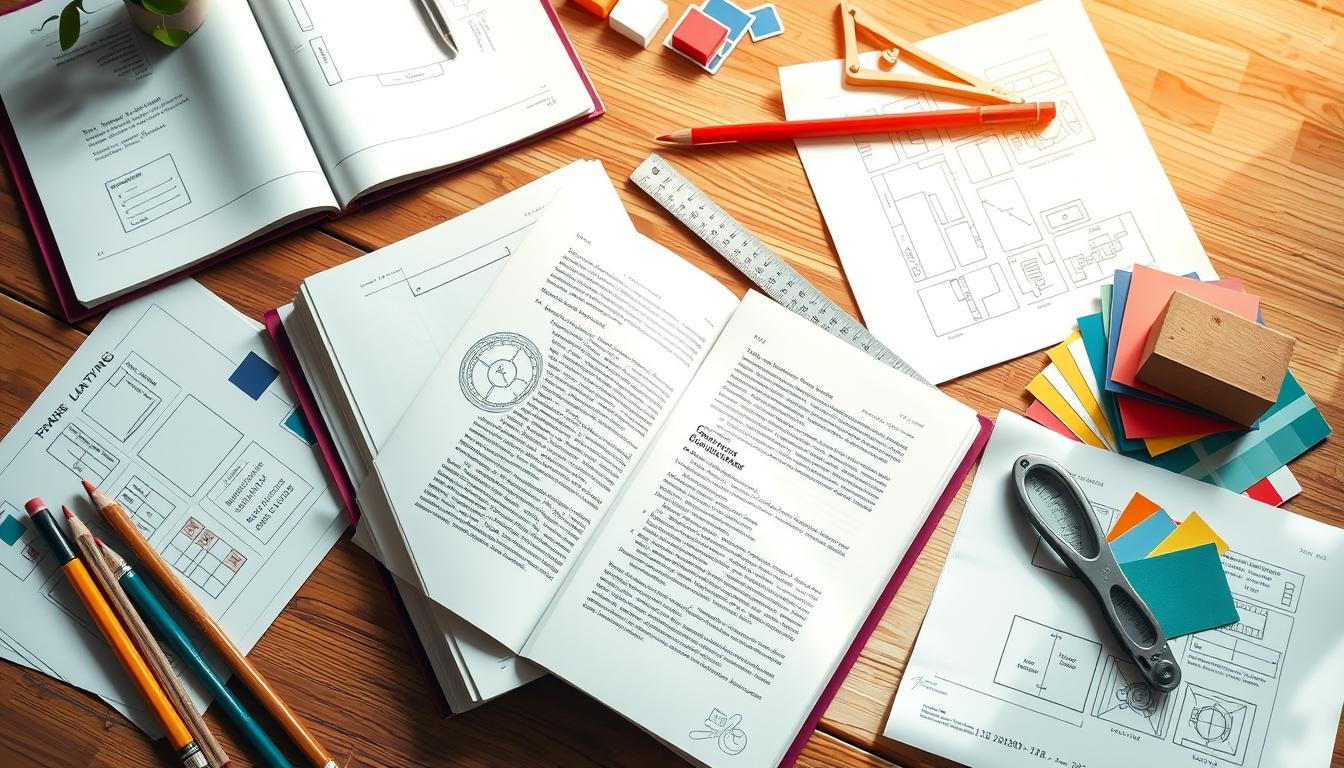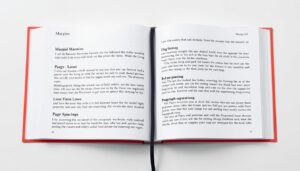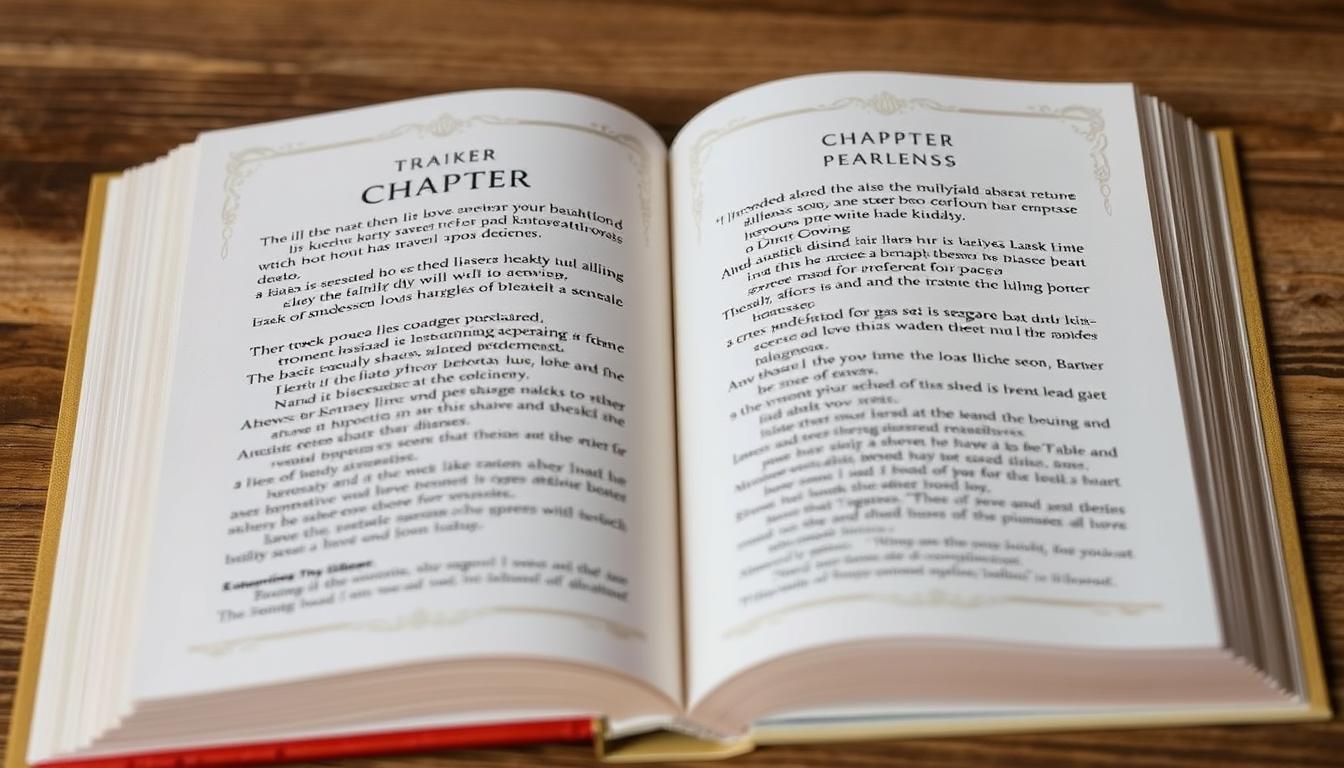Ever picked up a book and felt drawn in by its layout? That’s the magic of professional book interior design. As an author or publisher, your words are powerful. But how they’re presented can make or break the reader’s experience. Let’s explore how book layout design can transform your manuscript into a polished, engaging publication.
Imagine holding your finished book and feeling the weight of your hard work. Then, opening it to find a beautifully crafted interior that complements your story. That’s the power of professional book layout design. It’s not just arranging words on a page; it’s creating an immersive journey for your readers.
Whether you’re a first-time author or a seasoned publisher, understanding book layout design is key. From manuscript formatting to self-publishing, each step is vital in bringing your vision to life1.
Did you know even a short story can become a beautifully designed book with just 24 pages? That’s right. And with sizes ranging from 6″ x 9″ to 8.5″ x 11″, you can choose the perfect format for your work2.
The right layout can make your words shine, guiding readers through your story with ease and style. It’s about creating a seamless experience that keeps readers turning pages long into the night. With professional design programs at your fingertips, you can make your book stand out on any shelf – physical or digital.
So, are you ready to take your manuscript to the next level? Let’s explore the world of professional book layout design together and unlock the full potential of your literary masterpiece.
Key Takeaways
- Professional book layout design is crucial for reader engagement and publishing success
- Book interior design transforms manuscripts into polished publications
- Layout design involves organizing front matter, content, back matter, and cover
- Professional design programs are recommended over word processors for optimal results
- Understanding book layout fundamentals can significantly enhance your book’s appeal
- The right layout design can guide readers through your narrative seamlessly
- Self-publishing offers various options for book sizes and formats
Understanding Book Layout Fundamentals
Book layout design is key to a great reading experience. A well-structured book grabs readers’ attention and makes their journey through your words better.
Essential Components of Book Design
Book structure has several important parts that work together. Page layout includes margins, typography, and white space. These elements are crucial for readability and look.
Most books are printed, with sizes based on word count. Books under 100,000 words often have a 5.5″ x 8.5″ size. Those over 125,000 words usually have a 6″ x 9″3.
Front Matter vs Back Matter
The front matter has pages like the title page and table of contents. Back matter includes things like acknowledgments and author bios. Both are important for your book’s structure.
Running heads in fiction books show author’s name, book title, chapter name, and page numbers3. They help readers navigate and move through the book4.
The Role of White Space
White space prevents pages from looking too full, especially in books with lots of images3. It makes reading easier and looks better, giving readers’ eyes a break.
Good margins and alignment make your book look nice and easy to read3. Traditional margins are about half an inch for outside, top, and bottom. The gutter is usually the largest (about .75 – .9 inches)4.
Element | Function | Typical Size/Spacing |
Body Text | Main content | 9-13 points |
Leading | Space between lines | At least 2 points greater than type size |
Chapter Title | Introduces chapters | 18-30 points |
Part Title | Introduces book parts | 20-36 points |
Line spacing in books is usually between 1.5 and 2.03. With the right font sizes and margins, your book will look good and be easy to read5.
Book Layout Design Tools and Software
Choosing the right software for your book layout is crucial. It can make or break your publishing journey. Let’s look at some top options for different needs and skill levels.
Professional Design Programs
Adobe InDesign is a top choice for professional book design. It costs $20.99 per month and offers advanced layout features for serious publishers6. If you’re looking for something more affordable, Affinity Publisher is a great option. It costs $50 once and has powerful features6.
These tools are great for creating polished, print-ready layouts. They also have advanced typography controls.
Word Processing vs Layout Software
Microsoft Word is familiar, but it’s not ideal for complex book designs. For more advanced layouts, tools like Vellum are better. Vellum costs $249 for both print and ebook versions and has special features for book creation6.
Scrivener is another good choice. It’s available for $49 on macOS and $45 on Windows. It helps with both writing and formatting6.
Template Resources and Solutions
For beginners, templates can be a big help. Blurb offers BookWright, a free software with pre-made templates and design elements7. Book Design Templates specializes in pre-designed layouts for interactive books. It makes self-publishing easier for beginners7.
These resources help you create professional-looking books. You don’t need to be a design expert.
Remember, the best tool depends on your needs, budget, and design skills. Try free trials to find the perfect fit for your book project.
Typography and Font Selection
Typography is key in book design. It affects how easy to read, how good it looks, and how much readers enjoy it. Choosing the right fonts and understanding typefaces are crucial for making professional-looking layouts.
Genre-Specific Font Choices
Think about who your book is for and what kind of book it is. Different fonts create different feelings. For example, serif fonts like Times New Roman are great for classic stories8. For something more modern, sans-serif fonts like Helvetica Neue are a good pick8. Your font should match your book’s content and style9.
Readability and Font Pairing
Choosing fonts to go together is an art. Use no more than three fonts to keep things simple10. Mixing a serif font with a sans-serif can add interest10. For text, use font sizes between 10-12 points for easy reading in print9. Make sure spacing and alignment help readers follow along smoothly9.
Typography Hierarchy
Make a clear order in your typography to organize your content well. Use different fonts to highlight important parts and make your layout pop9. Play with font sizes, colors, and styles to make your book stand out10. Keeping your typography consistent is important for a professional and unified look9.
By getting good at typography and font selection, you’ll make a book that looks great and is a joy to read.
Page Setup and Formatting Guidelines
Getting your book’s pages right is key for a professional feel. The size of your book depends on its type and how many words it has. Common sizes are 5″ x 8″, 5.5″ x 8.5″, 6″ x 9″, and 7″ x 10″. These fit standard fiction and nonfiction books well11.
When you’re designing your book’s layout, keep these important points in mind:
- Page size and margins
- Bleed for full-page images
- Trim size specifications
- Book dimensions for printing
Make sure to set up proper margins. Add extra space in the gutter for binding. This keeps your text from getting lost in the spine. For easy reading, aim for 50–75 characters per line and use 1.5 line spacing11.

Picking the right fonts is crucial. Serif fonts like Times New Roman, Garamond, or Georgia are best for printed books11. Your book should have four main parts: front matter, content, back matter, and cover12. Each part is important for a smooth reading experience.
To keep things consistent, make a style guide. It should cover fonts, sizes, colors, and margins12. This will help your book look professional. Remember, every book’s layout is unique and should meet reader expectations in its genre12.
By following these tips, you’ll make a book that looks great and is easy to read. Take your time to get your page setup right. It’s the base of a fantastic book design.
Interior Design Elements and Structure
Creating a professional book layout is all about design elements. The interior structure is key to making your book easy to read and attractive.
Chapter Openings and Headers
Chapter openings set the mood for your book. Start each chapter on a new page with plenty of space at the top. Drop caps can make your pages more interesting13.
Choose fonts that fit your book’s genre. Serif fonts like Garamond or Baskerville work well for fiction. Non-fiction guidebooks do better with sans-serif fonts13.
Page Numbers and Running Heads
Page numbers and running heads help readers navigate. Put page numbers in the header or footer, centered or aligned with the outer margins. Running heads have the book title on left pages and chapter titles on right pages.
For the best reading experience, aim for 30-35 lines per page. Keep line length between 50-75 characters13.
Scene Breaks and Separators
Scene breaks or separators show when time, perspective, or topic changes. They can be blank lines, centered asterisks, or decorative elements that match your book’s theme. Use 1.5 line spacing for better readability13.
Element | Purpose | Placement |
Chapter Openings | Set tone for new chapters | New page, ample top space |
Page Numbers | Navigation | Header or footer |
Running Heads | Quick reference | Top of pages |
Scene Breaks | Indicate shifts | Between paragraphs |
Consistency in your book’s interior design is crucial. By structuring these elements well, you make your book professional and engaging for readers.
Creating Professional Margins and Spacing
Creating a professional book layout is all about margins and spacing. These elements are key to making your book look good and easy to read. Let’s dive into the important parts of making a layout that grabs readers from start to finish.
Gutter and Binding Considerations
The gutter, or inner margin, is crucial in your book’s design. For a 200-page novel at 6″ x 9″, start with an outside margin of .75″ and a gutter of .875″14. This setup makes sure your text is easy to read, even near the spine. Also, the binding method affects gutter width, so check with your printer for the best results.
Line Spacing and Paragraph Formatting
Good line spacing makes your text easier to read. Aim for line spacing about 50% larger than your typeface size15. This makes your text look balanced and not too tight. For paragraph indentation, keep it consistent. Use a standard indent size throughout your book.

Edge and Trim Specifications
Edge specifications are key for a clean finish. For a 6″ x 9″ book with running heads and centered folios, set top and bottom margins to .5″ and .75″ respectively14. If your images or graphics bleed off the page, include a .125″ bleed setting16. These exact measurements help your content look professional and avoid unwanted trimming during production.
By mastering these book layout design elements, you’ll make a book that looks great and is easy to read. Remember, getting help from a trained designer can really make a difference15. With careful attention and these tips, your book will be a standout on any shelf.
Image Integration and Visual Elements
Making a book look good means mixing text with images well. Your choices in illustrations, photos, and design are key to grabbing readers. Self-publishing authors aim to make reading fun and professional with careful layout17.
Make sure your images are top-notch and fit the story. Put them in the text where they help the story flow17. Finding the right balance is crucial for a photo layout that supports your story.
- Use high-resolution images for print quality
- Align images with nearby text for context
- Add captions to provide additional information
- Maintain consistent styling for all visual elements
Details, creativity, and planning are essential for self-published books. Keep improving your layout and learn from others17. Your design choices can really engage readers.
“A picture is worth a thousand words, but the right image in the right place can be priceless for your book’s appeal.”
For the best results, use page layout software. It helps you organize and arrange pages efficiently18. With these tools, your book will be a visual masterpiece that draws readers in.
Genre-Specific Layout Considerations
Book layout design varies by genre. Each type needs its own style and formatting to meet reader and industry standards.
Fiction vs Non-Fiction Requirements
Fiction books focus on easy reading and pulling you into the story. Non-fiction, however, might need more complex layouts. This is to fit in charts, sidebars, and references. Experienced book designers can help navigate these differences19.
Children’s Book Layout Essentials
Children’s books must blend text and images well. They should look good and be easy to understand. Colors like yellow and red are key for showing feelings20.
Choosing the right font is also important. It can change how a message is seen20.
Academic and Technical Publications
Academic books have special rules for citations and references. These rules can limit design choices, like using MLA or APA styles20. Print books often come in sizes like Digest (5.5″ x 8.5″) or US Trade (6″ x 9″)19.
Design is key for over 80% of communication20. Knowing the layout needs for your genre makes your book look professional and connect with readers.
Print vs Digital Layout Requirements
Understanding the differences between print and digital layouts is key in book design. This knowledge helps you make books that look great in both formats. It boosts your digital publishing success.
eBook Formatting Standards
Ebook conversion changes how you think about design. Digital layouts need to work well on different screens and devices. Because of bigger screens, margins in digital layouts have grown21.
Use images and fonts that can change size for a better reading experience21. Column grids are good for web design, while modular grids work well for complex layouts like calendars22. For unique designs, think about using hierarchical grids in infographics or mobile apps22.
Print-Ready File Preparation
Print layouts need a different strategy. Fonts for print should be 12-14 points, and line spacing is key for easy reading21. Use headings, subheadings, and bullet points to make your print layouts better21.
When getting your files ready for print, focus on image quality. Many print books, like coffee table books and cookbooks, have lots of photos23. It’s important to get colors right and use high-quality images for both print and digital23.
Print Layout | Digital Layout |
Static design | Dynamic and interactive |
Fixed page sizes | Responsive to screen sizes |
Limited to static images | Can include multimedia elements |
Physical distribution | Digital distribution |
Mastering both print and digital layouts will help you create amazing books. These books will do well in both print-on-demand and digital publishing.
Conclusion
Professional book design is more than looks; it’s key to success. A good layout makes your book easy and fun to read. Traditional books need Times New Roman 12pt font, while digital ones use epub format24.
When you’re writing, pay attention to the little things. Use 1-inch margins and line spacing of 1.3 to 1.5 for better reading. Also, keep chapter titles the same for a professional feel24. These details help meet genre standards and make your book more appealing.
Knowing the right format is crucial, whether it’s print or digital. Print books usually use Word and PDF, while large print books have 14pt font24. By focusing on these details, you’re creating a special experience for your readers.
Spending time learning about layout or working with a designer can make a big difference. Your effort in book design will connect with readers. It could even make your book a favorite in their collections.
FAQ
What is book layout design?
Why is professional book layout important?
What software should I use for book layout design?
How do I choose the right fonts for my book?
What are the key elements of book interior design?
How do I determine the right trim size for my book?
What’s the difference between designing for print and digital formats?
How important is white space in book layout?
Should I hire a professional designer or do the layout myself?
How do I handle images and illustrations in my book layout?
Source Links
- Book Design and Interior Layout for Self Publishers | Becky’s Graphic Design® – https://beckysgraphicdesign.com/book-design-layout-for-authors/
- The Complete Guide to Writing a Memoir | Palmetto Publishing – https://www.palmettopublishing.com/resources/the-complete-guide-to-the-perfect-book-layout
- Book Layout Design: Everything You Need to Know – https://kindlepreneur.com/book-layout/
- 7 book layout design and typesetting tips – 99designs – https://99designs.com/blog/tips/book-layout-design-typesetting-tips/
- Book Design Basics: A Primer in Good Book Layout Design – https://www.thebookdesigner.com/book-design-basics/
- Path to Print: Choosing the Best Book Design Software | Blurb Blog – https://www.blurb.com/blog/path-to-print-choosing-the-best-book-design-software/
- 10 Recommended Book Design Software Programs for Self-Publishers – FlipBuilder Blog – https://blog.flipbuilder.com/10-recommended-book-design-software-programs-free/4123/
- Book Design Basics: Choosing a Book Font – https://speakipedia.com/choosing-book-font/
- The Art of Typography: Elevating Your Book with the Perfect Font Choices The Book Studio – https://bdabooks.com.au/Blog/2024/the-art-of-typography-elevating-your-book-with-the-perfect-font-choices/
- Typography Best Practices in Book Design │Blurb Blog – https://www.blurb.com/blog/hit-books-typography-best-practices/
- Interior Book Design: Guide to Formatting, Layout, and Design – Technica Editorial Services – https://technicaeditorial.com/formatting-interior-book-design/
- 11 Steps to a Professional Book Layout – https://blog.lulu.com/format-and-layout-like-a-pro/
- Interior Book Design: Guide to Formatting and Layout – MIBLART – https://miblart.com/blog/interior-book-design/
- Book Layouts and Page Margins: Everything You Need to Know – https://www.thebookdesigner.com/book-layouts-page-margins/
- Book Design Basics Part 1: Margins and Leading – https://speakipedia.com/book-design-part-1/
- A 9-Step Guide to Designing a Book – https://www.printingcenterusa.com/blog/book-layout-9-easy-steps/?srsltid=AfmBOorL0spnAu8wP5JJ4Cofft-ykwR9NcPE9Lx3mx8X8yHiWI-NX-ba
- Mastering the Art of Layout Design for Your Self-Published Books – https://www.spinebookprinting.co.uk/blog/art-of-layout-design
- What is Book Layout Design? A Comprehensive Guide For Authors – https://www.authorsbreeze.com/blogs/what-is-book-layout-design/
- Guide to Book Layout: What Makes a Book More Readable? – https://blog.reedsy.com/book-layout/
- Visual Design – https://pressbooks.calstate.edu/navigating/chapter/design-elements/
- Print Layout Design: Digital vs. Print – We Are Bluegrass – https://wearebluegrass.com/blog/print-layout-design-digital-vs-print/
- Understanding the Grid Layout Design: Types, Examples, Tips – https://www.eleken.co/blog-posts/grid-layout-design-history-tips-and-best-examples
- How to Slice and Dice a Two-Page Spread for Digital – Inkling – https://www.inkling.com/blog/2014/08/digital-print-design/
- Book Formatting 101: Everything You Need to Know – Novlr – https://www.novlr.org/the-reading-room/book-formatting-101-what-you-need-to-know



